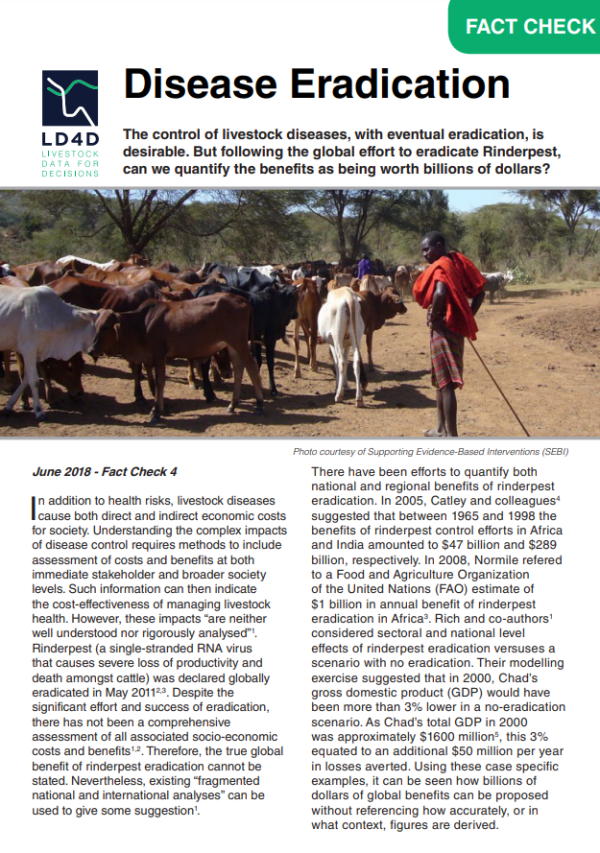Fact Check 4: Livestock Disease Eradication

Citation
The control of livestock diseases, with eventual eradication, is desirable. But following the global effort to eradicate Rinderpest, can we quantify the benefits as being worth billions of dollars?
I n addition to health risks, livestock diseases cause both direct and indirect economic costs for society. Understanding the complex impacts of disease control requires methods to include assessment of costs and benefits at both immediate stakeholder and broader society levels. Such information can then indicate the cost-effectiveness of managing livestock health. However, these impacts “are neither well understood nor rigorously analysed”1 . Rinderpest (a single-stranded RNA virus that causes severe loss of productivity and death amongst cattle) was declared globally eradicated in May 20112,3. Despite the significant effort and success of eradication, there has not been a comprehensive assessment of all associated socio-economic costs and benefits1,2. Therefore, the true global benefit of rinderpest eradication cannot be stated. Nevertheless, existing “fragmented national and international analyses” can be used to give some suggestion1. There have been efforts to quantify both national and regional benefits of rinderpest eradication. In 2005, Catley and colleagues4 suggested that between 1965 and 1998 the benefits of rinderpest control efforts in Africa and India amounted to $47 billion and $289 billion, respectively. In 2008, Normile refered to a Food and Agriculture Organization of the United Nations (FAO) estimate of $1 billion in annual benefit of rinderpest eradication in Africa3. Rich and co-authors1 considered sectoral and national level effects of rinderpest eradication versuses a scenario with no eradication. Their modelling exercise suggested that in 2000, Chad’s gross domestic product (GDP) would have been more than 3% lower in a no-eradication scenario. As Chad’s total GDP in 2000 was approximately $1600 million5, this 3% equated to an additional $50 million per year in losses averted. Using these case specific examples, it can be seen how billions of dollars of global benefits can be proposed without referencing how accurately, or in what context, figures are derived.
The modelling exercise in Chad highlighted that livestock value chains were more complex and broad than initially understood. Yet, it is highly likely that the costs of rinderpest eradication are outweighed by the benefits along value chains and in the broader economy1. A similar assessment conducted for India gave the same positive suggestions of benefits outweighing costs2.
Why is this information important?
Past case studies give limited suggestion that benefits of eradication outweigh the costs. However, the FAO has worked with partner organizations to develop a rigorous approach to evaluate the true global costs and benefits1. This has begun with an appreciation of the multiple impact levels (e.g. households and livelihoods, livestock and agriculture sectors, national and international economies). Understanding the risks, costs and rewards of future disease eradication efforts, particularly when resources are limited and investments require prioritisation, warrants such detailed evaluation.

Sources: 1: Rich et al., 2011, 2014 based on eradication; 2: Normile, 2008, FAO estimate based on eradication; 3: Catley et al, 2005 based on rinderpest control
References
- Rich, K., Roland-Holst, D., & Otte, J. 2011. The costs and benefits of rinderpest eradication. EMPRES Transboundary Animal Diseases Bulletin: Freedom From Rinderpest. Food and Agriculture Organization of the United Nations, Rome, Italy.
- Rich, K., Roland-Holst, D., & Otte, J. 2014. An assessment of the ex-post socio-economic impacts of global rinderpest eradication: Methodological issues and applications to rinderpest control programs in Chad and India. Food Policy, 44, 248-261.
- Normile, D. 2008. Driven to Extinction. Science, 319, 1606-1609.
- FAOSTAT. 2018 FAOSTAT: Food and Agricolture Data. FAO.
- Catley, A., Leyland, T., & Bishop, S. 2005. Policies, Practice and Participation in Complex Emergencies: The Case of Livestock Interventions in South Sudan. A case study for the Agriculture and Development Economics Division of the Food and Agriculture Organization, Tufts University, Medford (MA), USA.
Header photo: Cattle with herdsman. Peters A (SEBI)



